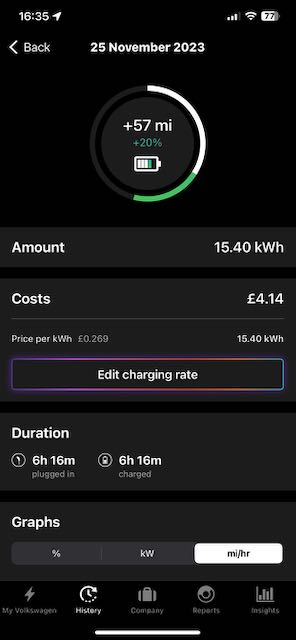We’d like to remind Forumites to please avoid political debate on the Forum.
This is to keep it a safe and useful space for MoneySaving discussions. Threads that are – or become – political in nature may be removed in line with the Forum’s rules. Thank you for your understanding.
📨 Have you signed up to the Forum's new Email Digest yet? Get a selection of trending threads sent straight to your inbox daily, weekly or monthly!
National Grid incoming supply house fuse upgrade questions
Comments
-
Granny chargers can easily give almost double that in a 7 hour window, even with losses.dunstonh said:Granny chargers will give you about 35 miles (late Spring/summer) or 24 miles Autumn/winter on a 7 hour charge (to match economy 7).
My charger provides 3kWh and the car typically states it is adding between 8 and 10 miles per hour.
Here's some screenshot from the EEVEE app (which gets its data indirectly from the car via the car manufacturer's servers) for a 6:16 duration charge at 3kWh, adding 15.40 kWh and a 57 miles (guestimated) range. This was at the end of last month (so cold).


I'm not saying all chargers/cars will get this (this is patently not the case), but blanket statements such the above (and the previous comments that 3-pin chargers can only go up to 2kW) are misleading.1 -
A friend of mine lives in a rural area, where properties are supplied by overhead lines from pole mounted transformers. His wife recently bought an EV, whereupon the charge point installer noted the 60A service fuse and recommended an upgrade before it could be fitted. They duly contacted the DNO who demanded that the Pole Mounted Transformer (shared with a neighbour) was uprated before they could uprate the service fuse.
Their neighbour stated no intention or desire to buy an EV and so he wouldn't share the cost, leaving them with a £20k quote for the upgrade, almost half the cost of the car.
Now they own a car, which can only be charged with a Granny Cable or during shopping trips to Tesco.
Whilst this probably won't apply in your case, it probably will apply to thousands of rural properties all over the Country with a similar set up. So worth keeping in mind ."Dont expect anybody else to support you, maybe you have a trust fund, maybe you have a wealthy spouse, but you never know when each one, might run out" - Mary Schmich1 -
chris1973 said:A friend of mine lives in a rural area, where properties are supplied by overhead lines from pole mounted transformers. His wife recently bought an EV, whereupon the charge point installer noted the 60A service fuse and recommended an upgrade before it could be fitted. They duly contacted the DNO who demanded that the Pole Mounted Transformer (shared with a neighbour) was uprated before they could uprate the service fuse.
Their neighbour stated no intention or desire to buy an EV and so he wouldn't share the cost, leaving them with a £20k quote for the upgrade, almost half the cost of the car.
Now they own a car, which can only be charged with a Granny Cable or during shopping trips to Tesco.
Whilst this probably won't apply in your case, it probably will apply to thousands of rural properties all over the Country with a similar set up. So worth keeping in mind .So don't upgrade the service fuse. If the DNO agrees, you can fit a charger to a 60A supply. Mine is set to 7.2kW (32A), but it will tell the car to slow down if I start overloading the supply.Alternatively, many chargers can be set to 3.6kW (16A), which is still better than a granny lead.If it sticks, force it.
If it breaks, well it wasn't working right anyway.3 -
Main fuse ratings are not the maximum power that can be delivered to a property, their only purpose is to protect the DNO wiring in the event of a major fault, so they are rated to be well above the normal supply current (so the fuse doesn't overheat). The maximum UK single phase supply is usually 15kVA, some older homes may have 10kVA or 12kVA supplies, it varied a lot from one region to another (essentially as all the old electricity boards ran as semi-independent entities).We are right next to a PMT, with a short run of 95mm² to our property, which is jointed down to the (now standard) 35mm² concentric supply cable to the main fuse. I requested the highest capacity supply possible, so have an agreed 15kVA supply, which has a 100A main fuse. This illustrates the differential between the supply rating and the fuse rating. For a unity PF a 15kVA supply can deliver 65A, obviously if the PF is not unity the current may well be a fair bit higher. The consequence of this is that in reality I can only (officially) draw about 65A from the supply continuously, even though there's a 100A fuse protecting the 35mm² incoming supply cable.Another illustration of the limits on supplies is to look at PMT ratings. The largest PMTs normally used in the UK are rated at 100kVA. Typically a 100kVA PMT may supply 20 or more homes. A bit of simple arithmetic shows that a 100kVA supply cannot deliver 15kVA to even 10 homes, let alone 20.The DNO get away with this apparent overload because of diversity rules that allow massive derating of consumer supplies based on the old use case that there wouldn't ever be a situation where they are all trying to draw their full 15kVA at the same time. Now we have car charge points coming in and they are very seriously screwing up the old diversity rules, as it's very likely that lots of homes will be drawing well over 7kW each for hours on end, at the same time (overnight charging ready for the next day, or to take advantage of off-peak rates). The result is that DNOs need to know about all charge point installations now, so they can keep a tally of areas where they will need to upgrade supplies. At least one DNO (WPD) is already committed to major works to upgrade supplies in their region, no doubt the others will follow.FWIW, most homes only need around 12kVA, perhaps less, to be able to run a car charge point OK, as that still leaves around 5kVA spare for the house long duration loads.1
-
JSHarris said:FWIW, most homes only need around 12kVA, perhaps less, to be able to run a car charge point OK, as that still leaves around 5kVA spare for the house long duration loads.Day 1: You can use the heatpump.Day 2: You can charge the EV.Day 3: You can use the washing machine, or the cooker, or the electric shower, or the tumble dryer or the kettle.Deep Joy. 😡0
-
Another way to look at this is to think of the bill. Lets assume, as a daft example, that a house draws 5kVA 24/7. That's very roughly 120kWh per day. At 35p/kWh that's going to cost £42/day.Now imagine using the current DNO maximum of 15kVA continuously, at an even more eye-watering £126/day . . .The reality is that no home is likely to need even 5kVA continuously, let alone the 15kVA supply we have. Our usage (including charging an EV mostly at home, running an ASHP, heating hot water, cooking, etc) averages just 12.9kWh/day, which is very roughly 0.54kVA. Adjusting this to allow for using 99.5% of that in just 7 hours overnight still only results in a continuous overnight demand of very roughly 1.85kVA.The key thing is going to be scheduling loads, hence the reason that smart car charge points are now mandatory, so demand can be safely managed. Even better will be when all EVs have V2G, as then they can help with load balancing at the LV network level.1
Confirm your email address to Create Threads and Reply

Categories
- All Categories
- 352.9K Banking & Borrowing
- 253.9K Reduce Debt & Boost Income
- 454.7K Spending & Discounts
- 246K Work, Benefits & Business
- 602K Mortgages, Homes & Bills
- 177.8K Life & Family
- 259.9K Travel & Transport
- 1.5M Hobbies & Leisure
- 16K Discuss & Feedback
- 37.7K Read-Only Boards





